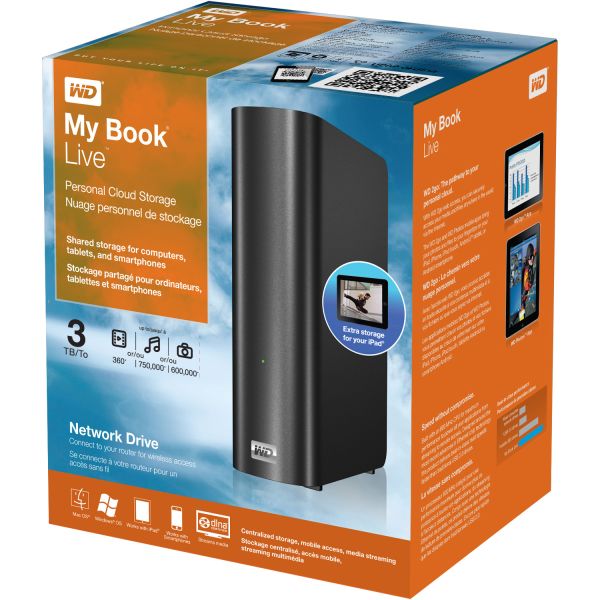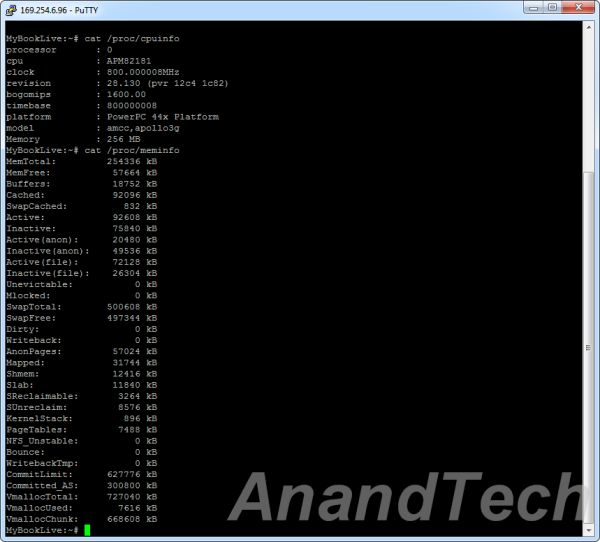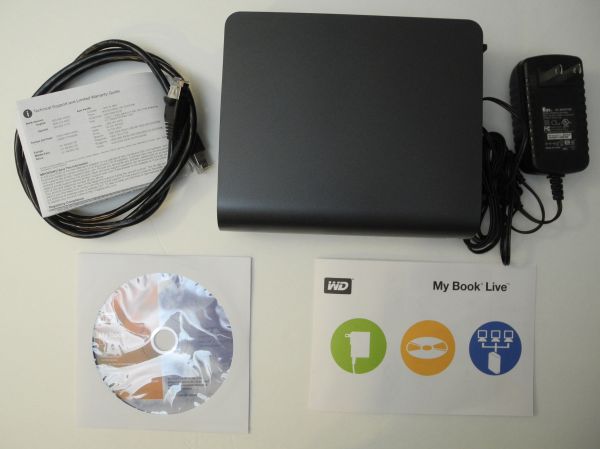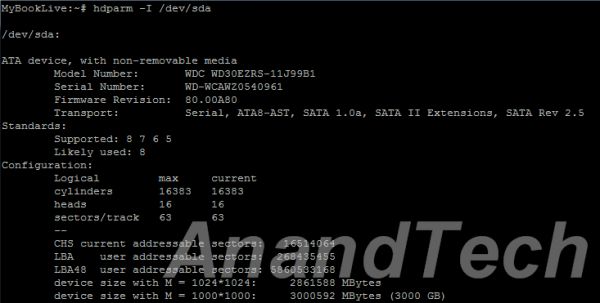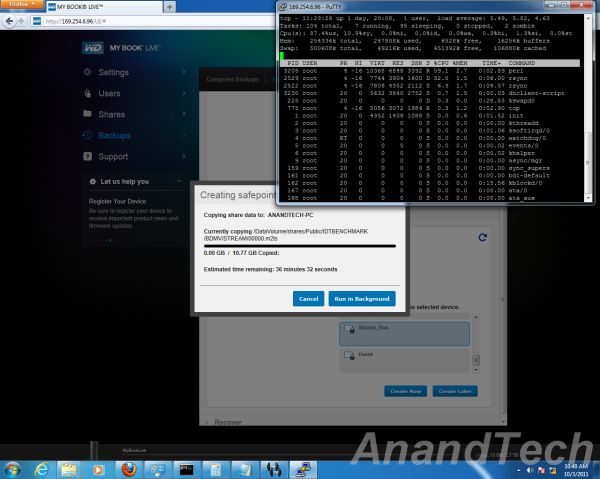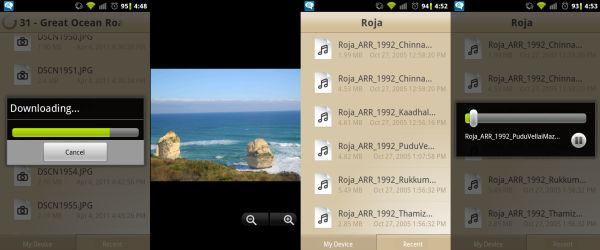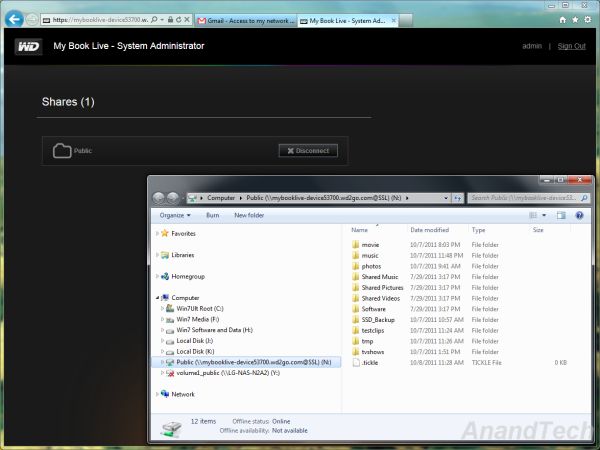
Original Link: https://www.anandtech.com/show/4952/wd-my-book-live-network-attached-hard-disk-review
WD My Book Live Network Attached Hard Disk Review
by Ganesh T S on October 11, 2011 6:30 AM EST- Posted in
- NAS
- Western Digital
- My Book Live
Network attached storage units have started becoming popular with the rise of powerful home networking solutions. Almost all mid-range and higher routers ship with USB ports. However, the transfer rates over USB are not quite satisfactory for most users. Many mainstream consumers also don't want the burden of configuring and running a NAS with multiple hard disks. On another note, companies like Apple and Google as well as startups like Dropbox and Box.net have made the cloud a buzzword amongst consumers. However, many users are still wary of trusting third party servers with the files. Western Digital has tried to address these two concerns with the My Book Live lineup.
The My Book Live lineup consists of 1 TB, 2 TB and 3 TB Western Digital hard disks in an external enclosure with a GbE port and a power adapter port. I had mentioned in one of the earlier NAS reviews that we have stopped seeing PowerPC based NAS platforms. With the Intel Atom pushing out Marvell chipsets from the mid-to-high end NAS market, Marvell chipsets took over the low end market based on the PowerPC platforms. Today, PowerPC platforms power network attached hard disks such as the My Book Live we are dealing with today.
The My Book Live is based upon the APM82181, a 800 MHz PowerPC 464 based platform (PDF). It has a host of features which are not utilized by the MyBook Live. For example, the PCI-E ports as well as the USB 2.0 OTG ports are fully disabled. The SATA port and GbE MAC are the only active components. The unit also has 256 MB of DRAM.
Before going into the review in detail, it is necessary to set expectations right. Potential customers should realize that the My Book Live doesn't provide data redundancy or availability. At best, it can complement an existing NAS in the network. This is aimed at users who want to add centrally accessible storage to their home network without the cost burden or setup hassles of a full fledged NAS. Even though the unit doesn't provide NAS features, it does include features to create periodic backups of its contents.
Western Digital sent us the the 3 TB version of the My Book Live for review. The unboxing and setup impressions, benchmarking results and a walkthrough of WD's personal cloud features are the various aspects covered in the rest of the review.
Western Digital has started following a distinctive red and blue packaging for all their product lines. The package makes the capabilities of the product very clear. A quick glance around the package by any customer would reveal that this is not a DAS unit and that the only available port is a GbE network connection. The contents of the package are as below:
- My Book Live main unit
- 3 ft. Cat 5E Ethernet cable
- 18 W power adapter
- Warranty and setup guide
- Software CD
For the purpose of benchmarking, the unit was directly connected to our NAS testbed. Once we were done with the benchmarking, the unit was loaded up with media files (and a few documents) and connected to the router to enable the unit to access the Internet.
Like all the other NAS units we have evaluated, it is quite straightforward to get up and running even without the use of the accompanying software CD. As the gallery below shows, the user just needs to navigate to the IP of the unit in a browser to get started with the setup.
It is possible to incorporate a owner password so that the unit's settings are secured. E-mail alert notifications can also be set up. Idle time to enter sleep mode can also be configured (from 10 min. to 1 hr.). The LAN configuration network mode is set to DHCP by default, though a static option is also available. The Windows workgroup name can also be configured. FTP service is also available.
Full-fledged NAS units provide S.M.A.R.T testing capabilities. While the My Book Live doesn't offer that explicitly, it does provide short and full diagnostic tests to check for bad sectors and other hard disk issues. There are two remote access options available, which we will deal with in a later section. Since the unit is geared towards home use, we have the Twonky Media Server and iTunes server to round up the multimedia capabilities.
It is also possible to set up multiple users and shares on the unit. New users can have private shares and also be allowed access to existing shares, if necessary. Shares can also be set up for media serving (of different types, if necessary).
The My Book Live unit can also be used as a target for backups (Time Machine in the Apple ecosystem and a WD SmartWare based solution for Windows machines). The unit's web interface also has helpful links to customer support and the WD forums for the device.
One of the best aspects of the My Book Live lineup is the fact that the units run a build of Debian Linux. WD also provides a way to enable SSH to the machine through a 'secret' URL [ http://MYBOOKLIVEIP/UI/SSH ]. Logging into SSH reveals many aspects of the unit which would otherwise be revealed only via a teardown. We already noted the Applied Micro platform and the 256 MB of DRAM in the previous section. The Linux shell also provides information about the hard disk in the unit. The dmesg command also revealed the presence of a BCM 54610 GbE PHY in the system.
The WD30EZRS is the 5400rpm 3.5" Western Digital Caviar Green 3TB model with a 64MB cache and a 6 Gbps SATA interface. Currently, 3TB drives are sold between $120 and $170. The 3 TB version of My Book Live can be purchased right now for less than $180. As such, the price difference is unbeatable for a GbE equipped 1-bay NAS enclosure.
The various operations triggered from the web interface are actually implemented with the standard Linux commands underneath. For example, setting up a safepoint (backing up the My Book Live to a network location) triggers the rsync command.
Since the underlying platform is based on Debian Linux, it is quite easy to hack into the unit. Adventurous users can use this guide for that purpose.
The My Book Live unit was put through the standard single user NASPT testing that has been used in all our NAS reviews. Testbed setup and benchmarking methodology can be found here. NFS shares can be set up from the SSH shell. However, we restricted ourselves to shares (SMB) that could be configured over the web interface.
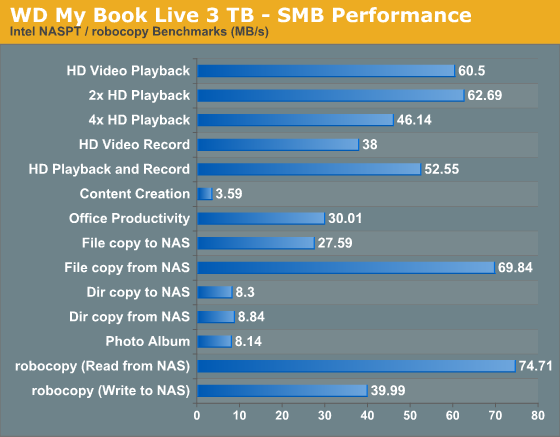
Even though WD claims up to 100 MBps read speeds in their marketing literature, we weren't able to hit it in our testing. Of course, this doesn't mean that WD's claims are erroneous (as our friends at SmallNetBuilder found out). All in all, the speeds are quite good for an entry level NAS unit, and more than respectable for a network attached hard disk.
Western Digital provides the WD2go and WD2go Pro apps for the iOS and Android devices. Together with the WD2go remote access via website, they form the personal cloud solution for the My Book Live. In this section, we will go over the WD2go Android app features as well as the web remote access solution. The WD2go Pro app provides extra security, sharing options and Dropbox like syncing functionality. However, we will just be looking at the free basic version in this section.
Upon initial launch, the Android WD2go app asks for an activation code which needs to be generated via the web interface of the My Book Live. After this code is input, one can see the attached devices on that network (I am assuming that multiple My Book Live units on a single network will end up with the same activation code). A few taps later, one can view and navigate the shares. The WD2go app settings include a configurable cache size (for storage of downloaded content) and the ability to clear it. The app also remembers a list of recently accessed files, which can also be cleared.
The app downloads the chosen file and launches it in the linked application. I was able to get this to work without issues for both pictures and music files. Pictures had to be fully downloaded for viewing on the mobile device.
Music files were streamed without any problems. Playback was started even before the file was downloaded in full. Videos were quite picky, though. I had to install RockPlayer Lite / Doubletwist in order to stream the videos. Since there is no transcoding going on at the My Book Live end, we are severely limited with respect to the nature of the video files which can be played back.
An interesting aspect is the connectivity status reported in the web interface. A relay connection implies that the data goes through WD's data center. A direct connection is obviously better in terms of performance. It is suggested that turning on uPnP in the router could help with this.
The PC WD2go feature is set up by registering an e-mail address for remote access. Clicking on the sign-up link set via e-mail enables the registering of a WD2go account on the WD2go.com website. A Java program loads in the background upon selecting the device on the webpage. This mounts the share as a network drive on the local machine.
Western Digital's personal cloud solution is quite effective in providing access to the My Book Live over the Internet, be it from a mobile device or a remote computer. Unlike other NAS vendors who require open ports in the router / expect users to register for a dynamic DNS service, WD's model is perfect for the mainstream consumer.
The Western Digital My Book Live turns out to be an effective and efficient network attached hard disk. It is easy to set up and use right out of the box, and also offers enough tweaks and features for the advanced users.
The unit is fanless (lots of ventilation slots all around the unit). Except for the occasional hard drive noise, the unit is quiet. When idle, the My Book Live consumed 8W. Upon entering the sleep mode, it dropped down to 4.2W. During periods of heavy network and disk traffic, the unit consumed between 11.4 and 12.2W.
For stress testing, we simultaneously read and wrote around 300 GB of data. Towards the end of this process (after approximately 4 hours), the maximum temperature we recorded on the chassis was 58C (the ambient temperature was 25C). However, the internal hard disk temperature reached 71C (as reported by hddtemp). The data transfer speeds also took a slight hit in order to not let the drive heat up any further. Anything above 60C is considered harmful to the health of the drive. As such, the current thermal solution in the My Book Live is not conducive to such heavy workloads. Fortunately, mainstream users considering network attached hard disks are not likely to generate such traffic.
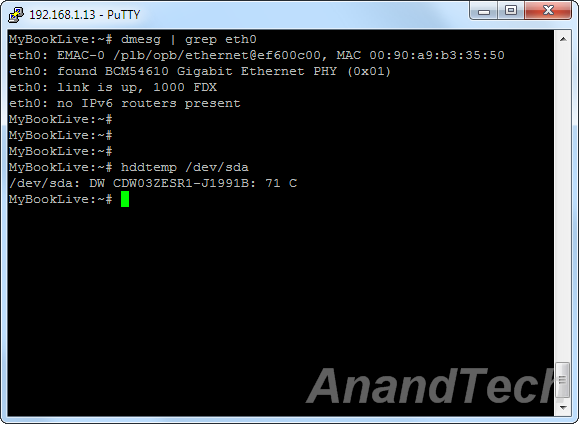
It is hard to find fault with the My Book Live when it performs as advertised (except for the claimed read speeds which can be achieved only under very specific conditions). However, it would be nice if this lineup was offered with the enterprise hard drives in addition to the consumer drives. Considering that there is no redundancy / availability built into this unit, data stored in the disk is much more at risk (particularly if it is not backed up periodically).
I also observed that the web interface slowed down when the unit was subjected to heavy SMB traffic. That is to be expected with such a low power chip powering the unit. Encryption of the hard drive's contents is also not supported out of the box, but users familiar with Linux can get that up and running. Despite qualifying as a good networked hard disk, it can't replace single bay NAS units due to the lack of USB / eSATA ports (which could have been easily added because the Applied Micro platform used in the unit does include USB support).
Except for these minor issues, it is quite easy to recommend the My Book Live 3 TB version. The low price premium over a barebones 3TB internal hard drive also works in its favour. If the periodic backup scheme is configured for data protection, there should be no surprises in store for the users who use the unit as a high capacity replacement for the router attached USB drives.

